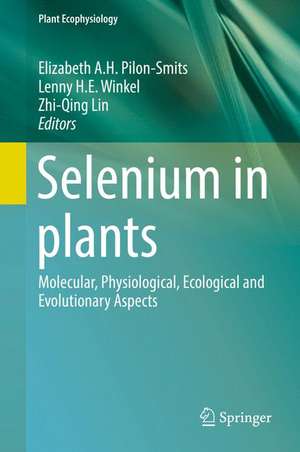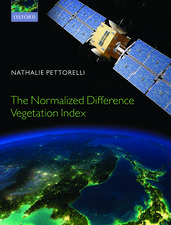Selenium in plants: Molecular, Physiological, Ecological and Evolutionary Aspects: Plant Ecophysiology, cartea 11
Editat de Elizabeth A.H. Pilon-Smits, Lenny H.E. Winkel, Zhi-Qing Linen Limba Engleză Hardback – 18 mai 2017
This book covers many facets of plant selenium (Se) accumulation: molecular genetics, biochemistry, physiology, and ecological and evolutionary aspects. Broader impacts and applications of plant Se accumulation also receive attention. Plant Se accumulation is very relevant for environmental and human health. Selenium is both essential at low levels and toxic at high levels, and both Se deficiency and toxicity are problems worldwide. Selenium can positively affect crop productivity and nutritional value. Plants may also be used to clean up excess environmental Se. Selenium in plants has profound ecological impact, and likely contributes to Se movement in ecosystems and global Se cycling.
| Toate formatele și edițiile | Preț | Express |
|---|---|---|
| Paperback (1) | 946.72 lei 6-8 săpt. | |
| Springer International Publishing – 18 aug 2018 | 946.72 lei 6-8 săpt. | |
| Hardback (1) | 952.72 lei 6-8 săpt. | |
| Springer International Publishing – 18 mai 2017 | 952.72 lei 6-8 săpt. |
Preț: 952.72 lei
Preț vechi: 1161.85 lei
-18% Nou
Puncte Express: 1429
Preț estimativ în valută:
182.32€ • 197.98$ • 153.15£
182.32€ • 197.98$ • 153.15£
Carte tipărită la comandă
Livrare economică 23 aprilie-07 mai
Preluare comenzi: 021 569.72.76
Specificații
ISBN-13: 9783319562483
ISBN-10: 3319562487
Pagini: 324
Ilustrații: XVI, 324 p. 32 illus.
Dimensiuni: 155 x 235 x 21 mm
Greutate: 0.65 kg
Ediția:1st ed. 2017
Editura: Springer International Publishing
Colecția Springer
Seria Plant Ecophysiology
Locul publicării:Cham, Switzerland
ISBN-10: 3319562487
Pagini: 324
Ilustrații: XVI, 324 p. 32 illus.
Dimensiuni: 155 x 235 x 21 mm
Greutate: 0.65 kg
Ediția:1st ed. 2017
Editura: Springer International Publishing
Colecția Springer
Seria Plant Ecophysiology
Locul publicării:Cham, Switzerland
Cuprins
1. Multi-Scale Factors and Processes Controlling Selenium Distributions in Soils.- 2. Biochemistry of Plant Selenium Uptake and Metabolism.- 3. Molecular Mechanisms of Selenium Responses and Resistance in Plants.- 4. Mechanisms of Plant Selenium Hyperaccumulation.- 5. Selenium and Algae: Accumulation, Tolerance Mechanisms and Dietary Perspectives.- 6. Bacteria versus Selenium: A View from the Inside Out.- 7. Selenium and the Plant Microbiome.- 8. Selenium Metabolism in Herbivores and Higher Trophic Levels Including Mammals.- 9. The Genetics of Selenium Accumulation by Plants.- 10. Manipulating Selenium Metabolism in Plants: A Simple Twist of Metabolic Fate can Alter Selenium Tolerance and Accumulation.- 11. Ecology of Selenium in Plants.- 12. Evolutionary Aspects of Plant Selenium Accumulation.- 13. Overview of Selenium Deficiency and Toxicity Worldwide: Affected Areas, Selenium-Related Health Issues, and Case Studies.- 14. Selenium Biofortification.- 15. Effects of Selenium on Plant Metabolism and Implications for Crops and Consumers.- 16. Overview and Prospects of Selenium Phytoremediation Approaches.
Textul de pe ultima copertă
This book focuses on selenium (Se) metabolism in plants. It not only covers plant genetic, biochemical and physiological processes but places these in the context of Se movement in the food chain and the global environment, as well as discusses ecological and evolutionary significance. While Se is an essential micronutrient, it is toxic at high levels, and there is a narrow window between Se adequacy and toxicity. More than a billion people and their livestock in low-Se regions have been estimated to be affected by Se deficiency, which compromises the immune system, thyroid activity, male fertility and mental function. In high-Se areas, Se toxicity is a problem. Selenium-accumulating plants may be used to alleviate Se deficiency in consumers (biofortification), or to remove environmental Se pollution (phytoremediation), both covered extensively in this volume. Plant species genetically vary in Se uptake, metabolism and tolerance. Some plants native to seleniferous soils can even hyperaccumulate Se up to 1.5% of their dry weight. The book reviews the latest knowledge about the processes involved in Se uptake, metabolism, tolerance and (hyper)accumulation, as well as successful approaches to optimize Se accumulation and speciation via classical crop breeding and genetic engineering. Global processes that control Se distribution and movement are reviewed, as are associated deficiency and toxicity issues. Relevant for Se bioavailability and for Se movement in the food chain, Se metabolism is also reviewed in prokaryotes and in mammalian consumers, and the nutritional benefits of plant Se on consumers are discussed. The reader will learn about the profound ecological effects of plant Se on interactions with herbivores, pollinators, microbes and other plants, and the likely selection pressures that drive the evolution of Se hyperaccumulation.
Caracteristici
igger selenium picture This book will be of interest to the diverse selenium research community, managers and inhabitants of seleniferous areas, and anyone who is interested in learning about this interesting and important element Relative to other books about selenium, this volume stands out in its scope. It strives to put plant selenium accumulation in the broadest possible context, including its relevance for global Se cycling, movement of Se in the food chain, and importance for human and environmental health. At the same time, the book thoroughly covers the molecular mechanisms of Se metabolism in plants, and includes succinct overviews of Se transformations in bacteria, algae and mammals, including health aspects in humans Relative to other books about selenium, which often consist of a series of chapters that are not necessarily meant to complement one another, this book strives to form a coherent story, each chapter contributing a facet of the fascinating b






















